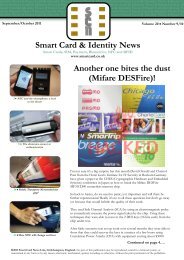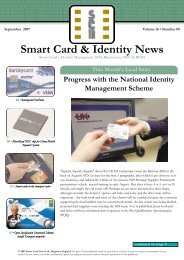Mifare, Oyster and ITSO Cards Hacked Smart Card & Identity News
Mifare, Oyster and ITSO Cards Hacked Smart Card & Identity News
Mifare, Oyster and ITSO Cards Hacked Smart Card & Identity News
You also want an ePaper? Increase the reach of your titles
YUMPU automatically turns print PDFs into web optimized ePapers that Google loves.
attacks. The <strong>Mifare</strong> card because it hasn't got a CPU is not capable of creating or checking such<br />
cryptographic messages. Consider the operation of a CPU <strong>Card</strong> as shown.<br />
Both the card <strong>and</strong> SAM can encipher messages or create <strong>and</strong> check cryptographic checksums as necessary<br />
<strong>and</strong> appropriate<br />
In this case the transactions operate between the SAM (Secure Access Module) <strong>and</strong> the card. Cryptographic<br />
protection operates between these end points. Consider for example the case where you want to increment<br />
the value of a purse stored on the card. The card is set up so that the comm<strong>and</strong> to increment the purse has a<br />
CCV attached, the chip checks this CCV before it effects the value load process. This cryptographic CCV is<br />
created by the Secure Access Module (SAM) attached to the terminal. Nowhere in this scenario are the<br />
cryptographic keys available in plain text. Even if the terminal is attacked with some Trojan software, the<br />
transaction records can be subsequently checked for authenticity. It is not possible for the Trojan operation<br />
to fool this process. In addition sequencing controls can be incorporated in the messages which are checked<br />
by the CPU to stop replays.<br />
User Authentication: The <strong>Mifare</strong> card has no facility for checking user PINs or passwords. This means that<br />
you cannot adequately bind a user to the card which is necessary in any form of <strong>Identity</strong> management<br />
scenario.<br />
Summary: Memory cards with discrete security logic such as <strong>Mifare</strong> can offer adequate security for some<br />
closed business scenarios. In the more open transaction model the increased security functionality offered by<br />
a CPU chip with cryptographic capability is highly desirable. In the light of the latest public attack on the<br />
Crypto-1 algorithm system integrators would be advised to upgrade to a more resilient algorithm. The NXP<br />
DESFire memory RFID product for example uses Triple DES but we see little advantage in a memory only<br />
device given the small overhead of a CPU micro-controller.<br />
LEGIC embeds badge <strong>and</strong> purse into NFC<br />
mobile phones<br />
Mobile telephony is already something we can’t imagine being without. New NFC (Near Field<br />
Communication) technology will revolutionise our daily transactions further still <strong>and</strong> make many deeds even<br />
easier. Buying a bus ticket, paying at a machine or kiosk, opening a door or accessing information services: in<br />
the future, the mobile telephone will be able to do all.<br />
NFC pilot project with <strong>and</strong> at Swisscom<br />
LEGIC, Swisscom <strong>and</strong> Selecta are pursuing new paths with this NFC pilot project. In the Swisscom’s<br />
modern buildings in Bern, Switzerl<strong>and</strong>, Swisscom staff use their mobile phones to get chilled drinks <strong>and</strong><br />
snacks from Selecta vending machines. The ability to connect a mobile phone to contactless applications,<br />
such as to make cashless payments using electronic purses, is opening up endless possibilities thanks to<br />
LEGIC’s new card-in-card solutions. For a long time these two worlds, with their different technologies,<br />
were not compatible. Buying drinks using an electronic purse was only possible with the contactless staff<br />
badge, while the mobile phone was used for st<strong>and</strong>ard communication purposes.<br />
<strong>Smart</strong> <strong>Card</strong> & <strong>Identity</strong> <strong>News</strong> • January 2008<br />
17
















